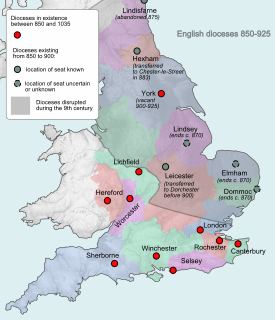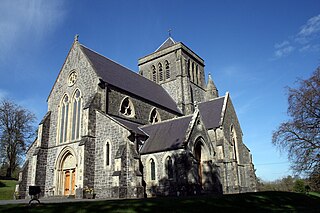Wilfrid was an English bishop and saint. Born a Northumbrian noble, he entered religious life as a teenager and studied at Lindisfarne, at Canterbury, in Gaul, and at Rome; he returned to Northumbria in about 660, and became the abbot of a newly founded monastery at Ripon. In 664 Wilfrid acted as spokesman for the Roman position at the Synod of Whitby, and became famous for his speech advocating that the Roman method for calculating the date of Easter should be adopted. His success prompted the king's son, Alhfrith, to appoint him Bishop of Northumbria. Wilfrid chose to be consecrated in Gaul because of the lack of what he considered to be validly consecrated bishops in England at that time. During Wilfrid's absence Alhfrith seems to have led an unsuccessful revolt against his father, Oswiu, leaving a question mark over Wilfrid's appointment as bishop. Before Wilfrid's return Oswiu had appointed Ceadda in his place, resulting in Wilfrid's retirement to Ripon for a few years following his arrival back in Northumbria.

Hexham Abbey is a Grade I listed place of Christian worship dedicated to St Andrew, in the town of Hexham, Northumberland, in Northeast England. Originally built in AD 674, the Abbey was built up during the 12th century into its current form, with additions around the turn of the 20th century. Since the Dissolution of the Monasteries in 1537, the Abbey has been the parish church of Hexham. In 2014 the Abbey regained ownership of its former monastic buildings, which had been used as Hexham magistrates' court, and subsequently developed them into a permanent exhibition and visitor centre, telling the story of the Abbey's history.
Berhtwald was the ninth Archbishop of Canterbury in England. Documentary evidence names Berhtwald as abbot at Reculver before his election as archbishop. Berhtwald begins the first continuous series of native-born Archbishops of Canterbury, although there had been previous Anglo-Saxon archbishops, they had not succeeded each other until Berhtwald's reign.

Eata, also known as Eata of Lindisfarne, was Bishop of Hexham from 678 until 681, and of then Bishop of Lindisfarne from before 681 until 685. He then was translated back to Hexham where he served until his death in 685 or 686. He was the first native of Northumbria to occupy the bishopric of Lindisfarne.
Trumbert was a monk of Jarrow, a disciple of Chad and later Bishop of Hexham.
Eadberht of Selsey was an abbot of Selsey Abbey, later promoted to become the first Bishop of Selsey. He was consecrated sometime between 709 and 716, and died between 716 and 731. Wilfrid has occasionally been regarded as a previous bishop of the South Saxons, but this is an insertion of his name into the episcopal lists by later medieval writers, and Wilfrid was not considered the bishop during his lifetime or Bede's.
Bosa was an Anglo-Saxon Bishop of York during the 7th and early 8th centuries. He was educated at Whitby Abbey, where he became a monk. Following Wilfrid's removal from York in 678 the diocese was divided into three, leaving a greatly reduced see of York, to which Bosa was appointed bishop. He was himself removed in 687 and replaced by Wilfrid, but in 691 Wilfrid was once more ejected and Bosa returned to the see. He died in about 705, and subsequently appears as a saint in an 8th-century liturgical calendar.
Cutheard of Lindisfarne was Bishop of Lindisfarne from 899 to around 915, although the see was administered from Chester-le-Street.

The Bishop of Lindsey was a prelate who administered an Anglo-Saxon diocese between the 7th and 11th centuries. The episcopal title took its name after the ancient Kingdom of Lindsey.

The Bishop of Durham is the Anglican bishop responsible for the Diocese of Durham in the Province of York. The diocese is one of the oldest in England and its bishop is a member of the House of Lords. Paul Butler has been the Bishop of Durham since his election was confirmed at York Minster on 20 January 2014. The previous bishop was Justin Welby, now Archbishop of Canterbury. The bishop is one of two who escort the sovereign at the coronation.

The Bishop of Lincoln is the ordinary of the Church of England Diocese of Lincoln in the Province of Canterbury.

The Bishop of Kilmore is an episcopal title which takes its name after the parish of Kilmore, County Cavan in Ireland. In the Roman Catholic Church it remains a separate title, but in the Church of Ireland it has been united with other bishoprics.
The Bishop of Meath is an episcopal title which takes its name after the ancient Kingdom of Meath. In the Roman Catholic Church it remains as a separate title, but in the Church of Ireland it has been united with another bishopric.
The Bishop of Down and Connor is an episcopal title which takes its name from the town of Downpatrick and the village of Connor in Northern Ireland. The title is still used by the Roman Catholic Church, but in the Church of Ireland it has been modified into other bishoprics.
Diuma was the first Bishop of Mercia in the Anglo-Saxon Kingdom of Mercia, during the Early Middle Ages.

Eadhæd was a medieval Bishop of Lindsey and sole Bishop of Ripon in the Medieval era.
The Bishop of Cornwall was an episcopal title which was used by Anglo-Saxons between the 9th and 11th centuries. In the mid 9th century there was a bishop at Dinuurrin, probably Bodmin, and possibly another at St Germans. At the end of the century Cornwall was part of the diocese of Sherborne, and Asser was given episcopal charge of Devon and Cornwall before his appointment to the full diocese. When he died in 909, Sherborne was divided into three dioceses, of which Devon and Cornwall were one. In Æthelstan's reign (924-939) there was a further division with the establishment of a separate Cornish diocese based at St Germans. Later bishops of Cornwall were sometimes referred to as the bishops of St Germans. In 1050, the bishoprics of Crediton and of Cornwall were merged and the Episcopal see was transferred to Exeter.

Frithubeorht was an eighth century medieval Bishop of Hexham.
The Bishop of Emly was a separate episcopal title which took its name after the village of Emly in County Tipperary, Republic of Ireland. In both the Church of Ireland and the Roman Catholic Church, it has been united with other sees.

Tidfrith or Tidferth was an early 9th-century Northumbrian prelate. Said to have died on his way to Rome, he is the last known Anglo-Saxon bishop of Hexham. This bishopric, like the bishopric of Whithorn, probably ceased to exist, and was probably taken over by the authority of the bishopric of Lindisfarne. A runic inscription on a standing cross found in the cemetery of the church of Monkwearmouth is thought to bear his name.









